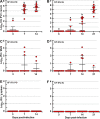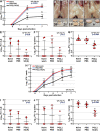Chlamydia-Specific IgA Secretion in the Female Reproductive Tract Induced via Per-Oral Immunization Confers Protection against Primary Chlamydia Challenge
- PMID: 33139380
- PMCID: PMC7927933
- DOI: 10.1128/IAI.00413-20
Chlamydia-Specific IgA Secretion in the Female Reproductive Tract Induced via Per-Oral Immunization Confers Protection against Primary Chlamydia Challenge
Abstract
Chlamydia trachomatis is an obligate intracellular pathogen that causes sexually transmitted disease. In women, chlamydial infections may cause pelvic inflammatory disease (PID), ectopic pregnancy, and infertility. The role of antibodies in protection against a primary Chlamydia infection is unclear and was a focus of this work. Using the C. muridarum mouse infection model, we show that intestinal mucosa is infected via intranasal (i.n.) or per-oral (p.o.) Chlamydia inoculation and that unlike the female reproductive tract (FRT) mucosa, it halts systemic Chlamydia dissemination. Moreover, p.o. immunization or infection with Chlamydia confers protection against per-vaginal (p.v.) challenge, resulting in significantly decreased bacterial burden in the FRT, accelerated Chlamydia clearance, and reduced hydrosalpinx pathology. In contrast, subcutaneous (s.c.) immunization conferred no protection against the p.v. challenge. Both p.o. and s.c. immunizations induced Chlamydia-specific serum IgA. However, IgA was found only in the vaginal washes and fecal extracts of p.o.-immunized animals. Following a p.v. challenge, unimmunized control and s.c.-s.c.-immunized animals developed Chlamydia-specific intestinal IgA yet failed to develop IgA in the FRT, indicating that IgA response in the FRT relies on the FRT to gastrointestinal tract (GIT) antigen transport. Vaginal secretions of p.o.-immunized animals neutralize Chlamydia in vivo, resulting in significantly lower Chlamydia burden in the FRT and Chlamydia transport to the GIT. We also show that infection of the GIT is not necessary for induction of protective immunity in the FRT, a finding that is important for the development of p.o. subunit vaccines to target Chlamydia and possibly other sexually transmitted pathogens.
Keywords: Chlamydia; IgA; antibodies; female reproductive tract; mucosa; mucosal vaccines; neutralizing antibodies; vaccination; vaccine.
Copyright © 2020 American Society for Microbiology.
Figures









Similar articles
-
Route of infection that induces a high intensity of gamma interferon-secreting T cells in the genital tract produces optimal protection against Chlamydia trachomatis infection in mice.Infect Immun. 1998 Sep;66(9):4030-5. doi: 10.1128/IAI.66.9.4030-4035.1998. Infect Immun. 1998. PMID: 9712743 Free PMC article.
-
The Chlamydia M278 Major Outer Membrane Peptide Encapsulated in the Poly(lactic acid)-Poly(ethylene glycol) Nanoparticulate Self-Adjuvanting Delivery System Protects Mice Against a Chlamydia muridarum Genital Tract Challenge by Stimulating Robust Systemic and Local Mucosal Immune Responses.Front Immunol. 2018 Oct 15;9:2369. doi: 10.3389/fimmu.2018.02369. eCollection 2018. Front Immunol. 2018. PMID: 30374357 Free PMC article.
-
Intranasal vaccination with Chlamydia pneumoniae induces cross-species immunity against genital Chlamydia muridarum challenge in mice.PLoS One. 2013 May 31;8(5):e64917. doi: 10.1371/journal.pone.0064917. Print 2013. PLoS One. 2013. PMID: 23741420 Free PMC article.
-
The mucosal immune response to Chlamydia trachomatis infection of the reproductive tract in women.J Reprod Immunol. 2009 Dec;83(1-2):173-8. doi: 10.1016/j.jri.2009.07.013. Epub 2009 Nov 5. J Reprod Immunol. 2009. PMID: 19896206 Review.
-
Chlamydia trachomatis: Protective Adaptive Responses and Prospects for a Vaccine.Curr Top Microbiol Immunol. 2018;412:217-237. doi: 10.1007/82_2016_6. Curr Top Microbiol Immunol. 2018. PMID: 27033698 Review.
Cited by
-
Enhanced IgA coating of bacteria in women with Lactobacillus crispatus-dominated vaginal microbiota.Microbiome. 2022 Jan 24;10(1):15. doi: 10.1186/s40168-021-01198-4. Microbiome. 2022. PMID: 35074009 Free PMC article.
-
Immunopathogenesis of genital Chlamydia infection: insights from mouse models.Pathog Dis. 2021 Mar 31;79(4):ftab012. doi: 10.1093/femspd/ftab012. Pathog Dis. 2021. PMID: 33538819 Free PMC article. Review.
-
A VCG-Based Multiepitope Chlamydia Vaccine Incorporating the Cholera Toxin A1 Subunit (MECA) Confers Protective Immunity Against Transcervical Challenge.Biomedicines. 2025 Jan 24;13(2):288. doi: 10.3390/biomedicines13020288. Biomedicines. 2025. PMID: 40002702 Free PMC article.
-
The Role of Mucoadhesion and Mucopenetration in the Immune Response Induced by Polymer-Based Mucosal Adjuvants.Polymers (Basel). 2023 Mar 24;15(7):1615. doi: 10.3390/polym15071615. Polymers (Basel). 2023. PMID: 37050229 Free PMC article. Review.
-
Chlamydia muridarum mutant CM-pGP3S as a novel attenuated live rectal vaccine protects against genital tract infection.Front Cell Infect Microbiol. 2025 May 13;15:1550455. doi: 10.3389/fcimb.2025.1550455. eCollection 2025. Front Cell Infect Microbiol. 2025. PMID: 40433661 Free PMC article.
References
-
- WHO. 2019. Sexually transmitted infections (STIs). https://www.who.int/en/news-room/fact-sheets/detail/sexually-transmitted.... Accessed 16 June 2019.
-
- CDC. 2018. Sexually transmitted disease surveillance 2018. https://www.cdc.gov/std/stats18/default.htm.
Publication types
MeSH terms
Substances
Grants and funding
LinkOut - more resources
Full Text Sources
Medical
Miscellaneous

